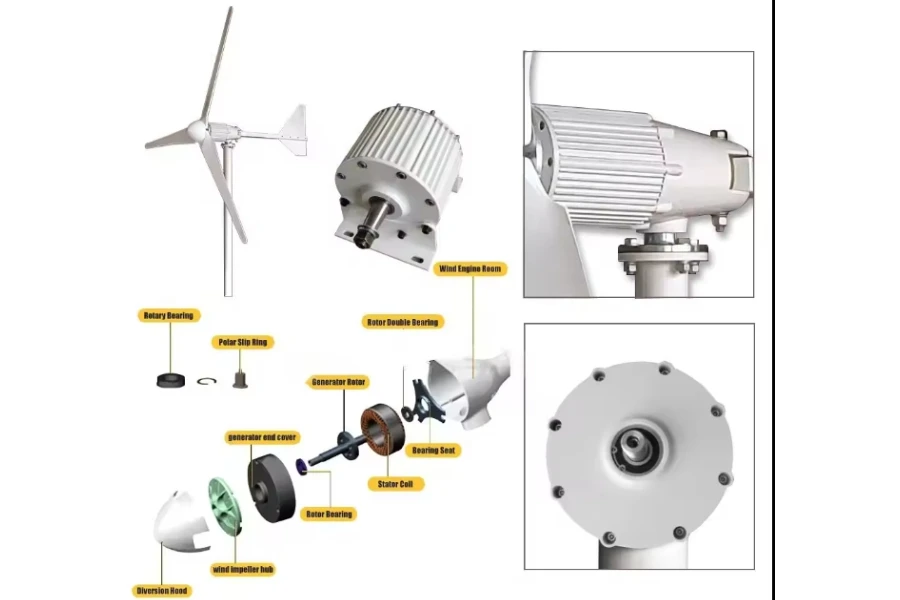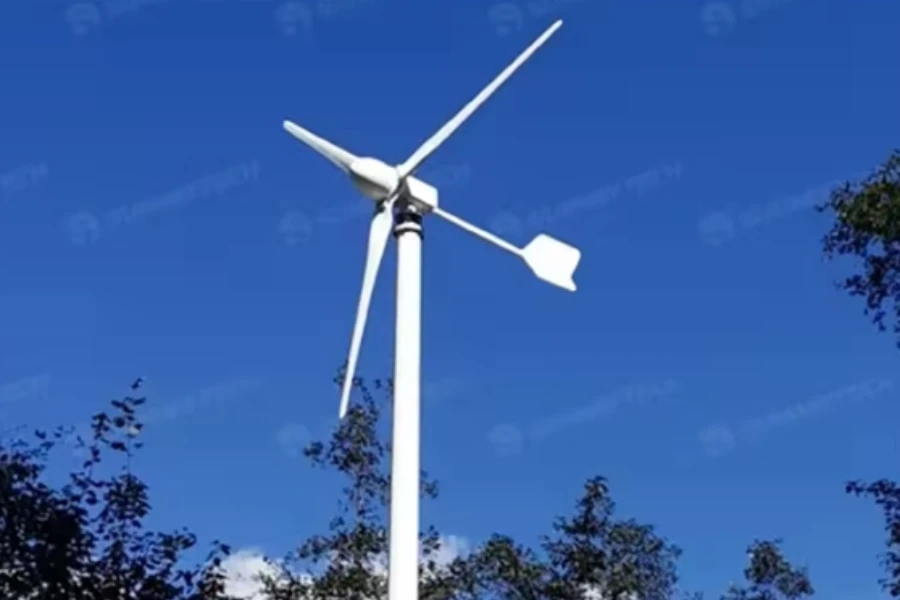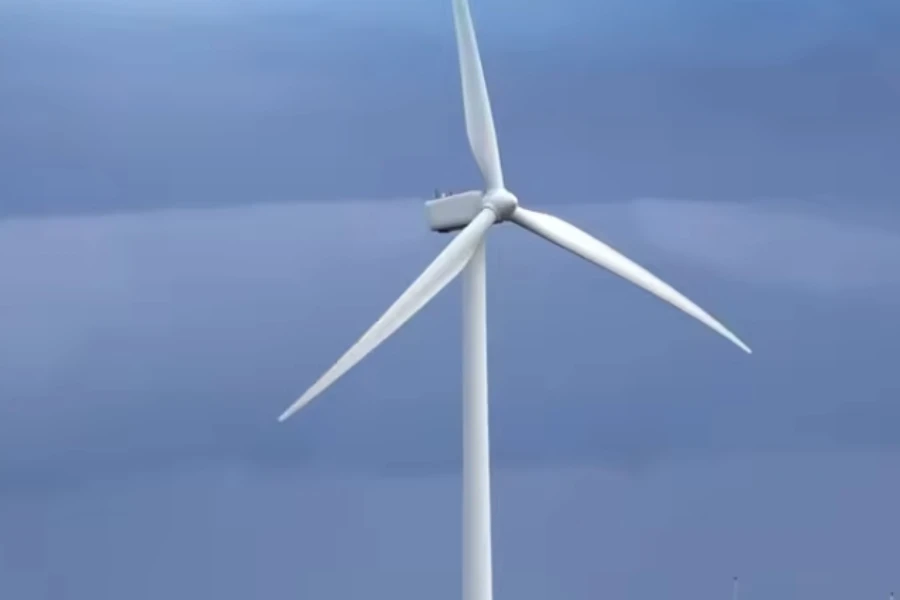Wind turbines have the capability of harnessing natural wind currents. These generators consist of towering turbines and sophisticated control systems that convert wind energy into clean electricity. Ideally suited to areas with steady winds, they are key to reducing dependence on fossil fuels and increasing energy security. Whether supplying power to cities or remote communities, wind turbines provide an efficient renewable energy solution.
This article will provide a brief introduction to wind turbines and then explore key factors to consider when purchasing a wind turbine, including their financial viability and the latest technology trends in 2024.
Table of Contents
What is a wind power generator?
Composition
Classification
Application scenarios
What to consider when choosing a wind power generator?
Financial viability
Technology trends
The bottom line
What is a wind power generator?
A wind power generator is a device that uses wind energy to convert into electricity, which is the core technology to achieve wind power generation. A wind power generator captures wind power through its blades, drives a rotor shaft to rotate, and then converts mechanical energy into electrical energy through a generator set.
Wind turbines are usually mounted on tall towers to capture a more stable and powerful wind. This type of power generation is completely renewable, clean, and produces no greenhouse gas emissions or other pollutants, and is therefore considered one of the most important sources of green energy.
Depending on the design and application, wind turbines can be categorized into two main types: horizontal axis and vertical axis, wherein horizontal axis wind turbines dominate the market due to their high efficiency and wide range of applications. Wind power technology has a long history of development, from simple windmills used for pumping water and grinding grain to modern high-efficiency wind turbines that provide clean power to the globe.
The design and construction of modern wind turbines integrates the results of advanced material science, meteorology and many other fields. As technology has continued to advance, wind turbines have become larger, more efficient, and able to operate at lower wind speeds, greatly improving the economics and applicability of wind power projects.
At the same time, the rapid development of wind power technology has benefited from the growing global demand to reduce carbon emissions and promote the use of renewable energy, and wind power has become one of the fastest growing energy technologies in the world.
Composition

A wind turbine consists of several key components, the following are the main components of a wind turbine:
Blades
Blades are the key component that captures the wind and converts it into rotational power. They are typically made of lightweight and strong materials, such as fiberglass or carbon fiber composites, to optimize efficiency and reduce wind resistance.
Rotor
The rotor, which includes the blades and hub, is the power source of a wind turbine. As the wind blows over the blades, the rotor turns, converting the kinetic energy of the wind into mechanical energy.
Generator
The generator is the component that converts mechanical energy into electrical energy. It is located at the top of the tower and is connected to the rotor by a shaft. As the rotor rotates, the generator produces alternating current (AC) or direct current (DC) for use in the grid or in a stand-alone system.
Tower
The tower supports the superstructure of the wind turbine, including the blades, rotor and generator. The height of the tower is critical to the performance of the wind turbine, as wind speed increases with height.
Pitch system
The pitch system controls the angle of the blades, or pitch angle, to adapt to different wind speeds and optimize the generator’s operating efficiency. The pitch system also protects the generator from damage by adjusting the angle of the blades to reduce the wind force during high wind speeds.
Yaw system
The yaw control system is responsible for orienting the wind turbine to face the wind. In horizontal axis wind turbines, the yaw system ensures that the rotor is always facing the wind to maximize the capture of wind energy.
Control system
The control system is the brain of the wind turbine. It monitors and adjusts the wind turbine’s operating conditions, including startup and shutdown, pitch control, yaw adjustment, and troubleshooting to ensure that the turbine operates at its optimal condition.
Classification

Wind turbines can be categorized into several different types based on their design and functional characteristics, mainly including:
Categorized by axis orientation
Horizontal axis wind turbines (HAWTs): this is the most common type of wind turbine and is characterized by the axis being placed horizontally with the rotor facing the wind direction. The HAWTs can be designed to be very tall and large in order to capture more wind energy, and are suitable for use in commercial-scale wind farms.
Vertical axis wind turbines (VAWTs): In this design, the axis is placed vertically so that the generator does not have to point into the wind. VAWTs are typically simpler in construction and less expensive to maintain, but may not be as efficient as HAWTs, and are suited for small-scale applications or urban environments.
Categorized by installation location
Onshore wind turbines: These are installed on land and can be stand-alone wind turbines or part of a large wind farm.
Offshore wind turbines: Installed in the ocean or a large lake, they are more expensive to build and maintain, but have a higher energy output due to the greater and more consistent wind speeds offshore.
Categorized by capacity
Small wind turbines: Usually refers to wind turbines with a rated power of less than a few tens of kilowatts, and are suitable for independent power supply in homes, small businesses or remote areas.
Large wind turbines: Rated power ranges from several hundred kilowatts to several megawatts, and are mainly used in large-scale commercial wind farms to provide power to the grid.
Categorized by application
Grid-connected wind turbines: The electricity produced by these turbines is supplied directly to the power grid and is a common form of large-scale wind power application.
Off-grid wind turbines: Used where there is no grid access, often in conjunction with batteries and/or other types of generators to provide power to remote areas or stand-alone systems.
Categorized by generator type
Fixed-speed wind turbines: traditional designs that run at a fixed speed, simple but not very efficient.
Variable speed wind turbine: improves the efficiency of wind energy utilization by adjusting the speed to accommodate changes in wind speed.
Application scenarios

Wind turbines have a wide range of applications as a renewable energy technology. Below are the main application scenarios for wind turbines:
Commercial wind farms
One of the most common application scenarios is large commercial wind farms, which consist of tens to hundreds of wind turbines installed on land or at sea. They provide large amounts of electricity to the grid, helping to reduce dependence on fossil fuels and lower greenhouse gas emissions.
Community wind
Community wind projects are smaller, often operated by communities or small businesses, and are designed to provide electricity to local communities. These projects help to promote energy autonomy and sustainable development in communities, while increasing awareness and acceptance of renewable energy among residents.
Off-grid electricity supply
Small wind turbines can be used as an off-grid power solution to provide electricity to residents and small facilities in remote areas or where the grid does not yet cover the area. These systems are often used in combination with solar panels and batteries to form hybrid energy systems that ensure stability of power supply.
Marine applications
Offshore wind turbines utilize the stronger winds at sea and are widely used in some coastal countries and regions. In addition to traditional power generation, offshore wind power technology can also be used in areas such as desalination and marine resource development.
What to consider when choosing a wind power generator?

When choosing a wind turbine, the following factors should be taken into account:
Areas with adequate wind resources
First, the wind resource of the potential installation site must be evaluated. Wind turbines are suitable for installation in areas with high and consistent wind speeds, such as near coastlines, open plains, mountaintops, or other unobstructed terrain. A wind resource assessment will determine the suitability of a particular site for wind power generation.
Large scale power supply requirements
For scenarios that require a large amount of power supply, such as industrial parks, large commercial facilities or city power supply, establishing a wind farm is an effective option. Wind farms can provide a sizable amount of clean energy to the grid and help reduce dependence on fossil fuels.
Off-grid power solutions
In remote areas or places not yet covered by the grid, wind turbines can provide an off-grid power solution to supply power to residents, distant research sites or remote tourist facilities. Especially in regions where wind resources are abundant, wind turbines are ideal for securing energy supplies.
Energy costs and economic considerations
In areas where electricity costs are high or expected to rise, investing in wind power can be a hedging strategy that may reduce energy costs in the long term. While the initial investment in wind turbines and related infrastructure is large, the operating costs are low and the overall economics of wind as a free resource are favorable.
Financial viability
The financial viability of wind-powered generators involves several aspects including initial installation cost, system size, capacity factor, and annual maintenance cost and system lifespan. Here are two brief examples to help you evaluate the viability of wind-powered generators for home and commercial use.
| Parameter | Small residential | Commercial project |
| Average wind speed requirement | At least 4.5 m/s | At least 4.5 m/s, larger systems may require higher |
| Initial installation cost | ~US$ 5,000 | ~US$ 3,000,000 |
| System size | ~5kW | ~3 MW |
| Capacity factor | ~20%(10~30%) | ~35%(20~50%) |
| Annual electricity production | ~8000 kWh | ~8.4 million kWh |
| Average electricity price | US$ 0.17/kWh | US$ 0.13/kWh |
| Annual maintenance cost | US$ 0 – $200 | ~US$ 20,000 |
| Annual electricity cost savings | ~US$ 1300 | ~US$ 1090,000 |
| System lifespan | 20 years | 20 – 25 years |
| Electricity sale potential | Depends on local grid policies | Greater potential, especially for large projects |
Technology trends
Wind power technology is experiencing rapid growth and innovation, and the following are the key trends in wind power technology:
Larger and more efficient turbines
With advances in materials science and engineering, new generations of wind turbines are becoming larger and more efficient. Large turbines are able to capture more wind energy and operate at lower wind speeds, improving power generation efficiency and reliability. Especially in the field of offshore wind power, the application of giant turbines is becoming more and more common.
Floating wind power technology
Floating wind technology allows wind turbines to be deployed in deep water areas, significantly expanding the range of available offshore wind farms. This technology supports wind turbines by floating platforms on the water’s surface, allowing wind projects to access stronger and more stable wind resources away from shore.
Intelligent and digital
Intelligent management and operation and maintenance of wind farms is another important trend. By leveraging Internet of Things (IoT) technology, big data analytics and artificial intelligence (AI), operators are able to monitor turbine status in real time, predict maintenance needs, optimize power generation efficiency and reduce maintenance costs.
Energy storage integration
Integrating energy storage systems with wind farms has become possible as the cost of energy storage technology decreases and performance improves. Energy storage not only balances the intermittent nature of wind power generation, but also improves the flexibility of the power system and increases the value of wind power in the energy market.
Enhanced pitch control system
By further optimizing the pitch control system, the new generation of wind turbines is able to adjust the blade angle more accurately to adapt to changing wind speeds and directions, increasing power generation efficiency while reducing structural loads and extending turbine life.
The bottom line
Wind turbines, which utilize wind energy to convert it into electricity, are the core devices of clean, renewable energy technologies. As the global demand for sustainable energy increases, wind power has become a key way to obtain clean energy. Technology trends show that modern wind turbines are evolving to be larger and more efficient.
These advances not only improve the efficiency and reliability of wind power, but also provide new opportunities for wind power to be used in remote areas, offshore, and in urban environments. With technological innovations and cost reductions, wind turbines will continue to play an important role in the global energy market.
Finally, if you are interested in purchasing a wind power generator for your home or business, you can visit this link.




